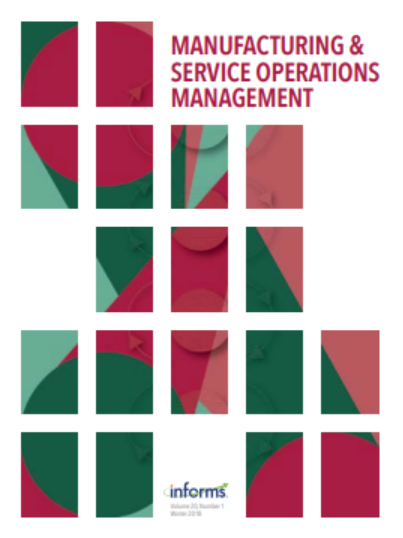城市警务行动中的规范分析
IF 4.8
3区 管理学
Q1 MANAGEMENT
M&som-Manufacturing & Service Operations Management
Pub Date : 2021-11-09
DOI:10.1287/msom.2021.1022
引用次数: 2
摘要
问题定义:我们考虑规范性警务的案例,即数据驱动的警车分配到城市的不同区域。我们分析了预测、优化和评估方面的关键问题,以及不同质量措施和犯罪类型之间的权衡。学术/实践相关性:数据驱动的规范分析在运营管理研究中获得了大量关注,有效的警务是世界上几乎每个城市运营的核心。鉴于智慧城市计划中收集的大量数据越来越多,以及全球城市中心面临的日益严峻的安全挑战,我们的工作为城市环境中规范性分析应用程序的开发和评估提供了新颖的见解。方法:我们使用旧金山市的犯罪和辅助数据进行计算研究。我们分析了强预测方法和弱预测方法,以及两种优化公式,代表了警车分配的威慑和响应时间的影响。我们分析了这些影响之间以及不同犯罪类型之间的权衡。结果:我们发现即使较弱的预测方法也可以产生关于威慑和反应时间的帕累托有效结果。我们确定了三种不同的预测方法和优化目标组合的原型,它们构成了我们分析的配置中的帕累托边界。此外,对多种犯罪类型进行优化,通常会在一个结果度量上降低单一类型的性能,但可以在另一个结果度量上提高它。管理意义:虽然整合所有相关犯罪类型的优化在理论上是可能的,但实际上具有挑战性,因为每种犯罪类型都需要一个一致的权重。我们提出了一个框架,结合了对关键犯罪类型子集的预测和优化,并探索对其余类型的影响,以支持在实践中实施以运营为重点的智慧城市解决方案。本文章由计算机程序翻译,如有差异,请以英文原文为准。
Prescriptive Analytics in Urban Policing Operations
Problem definition: We consider the case of prescriptive policing, that is, the data-driven assignment of police cars to different areas of a city. We analyze key problems with respect to prediction, optimization, and evaluation as well as trade-offs between different quality measures and crime types. Academic/practical relevance: Data-driven prescriptive analytics is gaining substantial attention in operations management research, and effective policing is at the core of the operations of almost every city in the world. Given the vast amounts of data increasingly collected within smart city initiatives and the growing safety challenges faced by urban centers worldwide, our work provides novel insights on the development and evaluation of prescriptive analytics applications in an urban context. Methodology: We conduct a computational study using crime and auxiliary data on the city of San Francisco. We analyze both strong and weak prediction methods along with two optimization formulations representing the deterrence and response time impact of police vehicle allocations. We analyze trade-offs between these effects and between different crime types. Results: We find that even weaker prediction methods can produce Pareto-efficient outcomes with respect to deterrence and response time. We identify three different archetypes of combinations of prediction methods and optimization objectives that constitute the Pareto frontier among the configurations we analyze. Furthermore, optimizing for multiple crime types biases allocations in a way that generally decreases single-type performance along one outcome metric but can improve it along the other. Managerial implications: Although optimization integrating all relevant crime types is theoretically possible, it is practically challenging because each crime type requires a collectively consistent weight. We present a framework combining prediction and optimization for a subset of key crime types with exploring the impact on the remaining types to support implementation of operations-focused smart city solutions in practice.
求助全文
通过发布文献求助,成功后即可免费获取论文全文。
去求助
来源期刊

M&som-Manufacturing & Service Operations Management
管理科学-运筹学与管理科学
CiteScore
9.30
自引率
12.70%
发文量
184
审稿时长
12 months
期刊介绍:
M&SOM is the INFORMS journal for operations management. The purpose of the journal is to publish high-impact manuscripts that report relevant research on important problems in operations management (OM). The field of OM is the study of the innovative or traditional processes for the design, procurement, production, delivery, and recovery of goods and services. OM research entails the control, planning, design, and improvement of these processes. This research can be prescriptive, descriptive, or predictive; however, the intent of the research is ultimately to develop some form of enduring knowledge that can lead to more efficient or effective processes for the creation and delivery of goods and services.
M&SOM encourages a variety of methodological approaches to OM research; papers may be theoretical or empirical, analytical or computational, and may be based on a range of established research disciplines. M&SOM encourages contributions in OM across the full spectrum of decision making: strategic, tactical, and operational. Furthermore, the journal supports research that examines pertinent issues at the interfaces between OM and other functional areas.
 求助内容:
求助内容: 应助结果提醒方式:
应助结果提醒方式:


